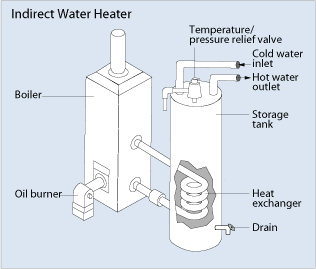Tankless Coil and Indirect Water Heaters
Tankless coil and indirect water heaters use a home's space heating system to heat water. They're part of what's called integrated or combination water and space heating systems.
How They Work
A tankless coil water heater uses a heating coil or heat exchanger installed in a main furnace or boiler. Whenever a hot water faucet is turned on, the water flows through the heat exchanger. These water heaters provide hot water on demand without a tank, like a demand water heater, but because they rely on the furnace or boiler to heat the water directly, tankless coil water heaters work most efficiently during cold months when the heating system is used regularly. That's why they can be an inefficient choice for many homes, especially for those in warmer climates.

Indirect water heaters offer a more efficient choice for most homes, even though they require a storage tank. An indirect water heater uses the main furnace or boiler to heat a fluid that's circulated through a heat exchanger in the storage tank. The energy stored by the water tank allows the furnace to turn off and on less often, which saves energy. Therefore, an indirect water heater is used with a high-efficiency boiler and well-insulated tank can be the least expensive means of providing hot water.

Indirect systems can be fired by gas, oil, propane, electric, solar energy, or a combination of any of these. Tankless systems are typically electric or gas-fired. Also, these integrated or combination water heating systems not only can work with forced air systems but also with hydronic or radiant floor heating systems.
Selecting a Combination Water and Space Heating System
Integrated or combination water and space heating systems usually cost more than a separate water heater and furnace or boiler, but installation and maintenance costs may be less. For example, you won't need multiple utility hook-ups since there's one source of heat. There also aren't as many moving parts to maintain or service. Some of these high efficiency systems may also provide you with lower utility costs.
Most combination water and space heating systems are usually designed for new construction. However, there are some retrofit units available that can work with an existing water heater.
When selecting a system, you need to consider its size. The sizing of a combination system involves some different calculations than those used for sizing a separate water heating or space heating system. It's best left to a qualified plumbing and heating contractor.
To determine the energy efficiency of a combination water and space heating system, use its combined appliance efficiency rating (CAE). The higher the number, the more energy efficient. Combination appliance efficiency ratings vary from 0.59 to 0.90.
Installing and Maintaining the System
Proper installation and maintenance of your combination water and space heating system can optimize its energy efficiency.
Proper installation of your system will depends on many factors. These factors include fuel type, climate, local building code requirements, and safety issues. Therefore, it's best to have a qualified plumbing and heating contractor install it. Be sure to do the following when selecting a contractor:
- Request cost estimates in writing
- Ask for references
- Check the company with your local Better Business Bureau
- See if the company will obtain a local permit if necessary and understands local building codes, etc.
Periodic maintenance of your system can significantly extend your water heater's life and minimize loss of efficiency. Consult your installer and read your owner's manual for specific maintenance recommendations.
Improving Energy Efficiency
After your combination system is properly installed and maintained, try some additional energy-saving strategies for water heating and space heating and cooling to help lower your utility bills.


























